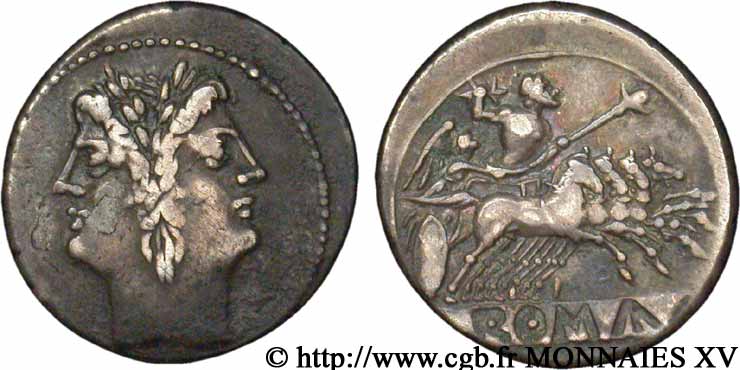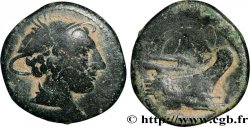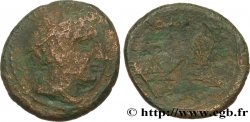v15_1457 - REPÚBLICA ROMANA - ANÓNIMO Didrachme
MONNAIES 15 (2002)
Precio de inicio : 155.00 €
Valoración : 320.00 €
Precio realizado : 171.00 €
Número de ofertas : 2
Oferta más alta : 280.00 €
Precio de inicio : 155.00 €
Valoración : 320.00 €
Precio realizado : 171.00 €
Número de ofertas : 2
Oferta más alta : 280.00 €
Tipo : Didrachme
Fecha: c. 225-215 AC.
Nombre del taller / ciudad: Rome ou Italie
Metal: plata
Diámetro: 21 mm
Eje de acuñación: 12 h.
Peso: 6,38 g.
Grado de rareza: R1
Comentarios sobre el estado de conservación:
Beau portrait de Janus. Patine foncée de collection. Légèrement décentré au revers
N° en los catálogos de referencia :
Pedigrí:
Cet exemplaire provient d’une très vieille collection constituée avant la première Guerre mondiale
Anverso
Titulatura del anverso: ANÉPIGRAPHE.
Descripción del anverso: Tête imberbe de Janus.
Reverso
Titulatura del reverso: ROMA EN CREUX À L'EXERGUE DANS UN CARTOUCHE EN RELIEF.
Descripción del reverso: Jupiter dans un quadrige galopant à droite, conduit par la Victoire tenant les rênes, brandissant un foudre de la main droite et tenant un sceptre long de la gauche.
Comentario
Ce type très ancien n’a certainement pas été copié directement par les Celtes. Néanmoins, le monnayage d’or des Médiomatriques (LT. 8933 et 8937) semble directement inspiré par le didrachme romano campanien. Certaines petites monnaies d’or au type de la tête de Janus (KO. 13 et 14) sont peut-être directement copiées sur le monnayage italo-punique de Capoue (GC. 287), frappé entre 216 et 211 avant J.-C. Il est possible que les statères à la double tête barbue (LT. 9899 = KO. 540-547) soit des adaptations libres du didrachme romain en passant par le prototype du tétradrachme de Philippe II de Macédoine. Faut-il rappeler que de nombreux mercenaires celtes servaient dans les différentes armées, grecques, carthaginoises, voire romaines et que ces hommes étaient soldés en monnayages locaux, et que d’autre part le pillage était largement répandu. Nos mercenaires pouvaient donc se retrouver avec de nombreux types différents qu’ils exportèrent vers leur nation d’origine. Ce type ne semble pas avoir inspiré les bronzes CAITIO (BN 2614-2619), pas plus que le bronze des Suessions (LT. 8106).
This very ancient type was certainly not directly copied by the Celts. Nevertheless, the gold coinage of the Mediomatrici (LT. 8933 and 8937) seems directly inspired by the Romano-Campanian didrachm. Some small gold coins with the Janus head type (KO. 13 and 14) are perhaps directly copied from the Italo-Punic coinage of Capua (GC. 287), struck between 216 and 211 BC. It is possible that the staters with the double bearded head (LT. 9899 = KO. 540-547) are free adaptations of the Roman didrachm via the prototype of the tetradrachm of Philip II of Macedon. It should be remembered that many Celtic mercenaries served in the various armies, Greek, Carthaginian, and even Roman, and that these men were paid in local coins, and that, on the other hand, pillaging was widespread. Our mercenaries could therefore end up with many different types that they exported to their home nation. This type does not seem to have inspired the CAITIO bronzes (BN 2614-2619), nor the bronze of the Suessiones (LT. 8106)
This very ancient type was certainly not directly copied by the Celts. Nevertheless, the gold coinage of the Mediomatrici (LT. 8933 and 8937) seems directly inspired by the Romano-Campanian didrachm. Some small gold coins with the Janus head type (KO. 13 and 14) are perhaps directly copied from the Italo-Punic coinage of Capua (GC. 287), struck between 216 and 211 BC. It is possible that the staters with the double bearded head (LT. 9899 = KO. 540-547) are free adaptations of the Roman didrachm via the prototype of the tetradrachm of Philip II of Macedon. It should be remembered that many Celtic mercenaries served in the various armies, Greek, Carthaginian, and even Roman, and that these men were paid in local coins, and that, on the other hand, pillaging was widespread. Our mercenaries could therefore end up with many different types that they exported to their home nation. This type does not seem to have inspired the CAITIO bronzes (BN 2614-2619), nor the bronze of the Suessiones (LT. 8106)








 Informar de un error
Informar de un error Imprimir la página
Imprimir la página Comparte mi selección
Comparte mi selección Haz una pregunta
Haz una pregunta Consignar / vender
Consignar / vender
 Descriptivo
Descriptivo











